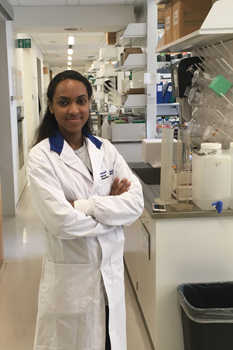Meet Lina Elfaki, an advocate for diversity in STEMM

By Ana Gajic

Lina Elfaki
Lina Elfaki is a master’s student in the Keenan Research Centre for Biomedical Science, chairwoman of the St. Michael’s Research Student Association (SRSA) and an advocate for diversity in science, technology, engineering, math and medicine (STEMM) fields.
When she’s not putting together events to engage youth in STEMM, working with SRSA to build programming for research students, or attending classes at the University of Toronto, Elfaki is busy running experiments on new treatments for cardiovascular disease. Right now, she is working in Dr. Howard Leong-Poi’s lab and researching tiny bubbles — known as microbubbles — that could one day be used to deliver therapy for abdominal aortic aneurysms, which happen when the abdominal aorta swells.
We sat down with Elfaki to learn more about her dedication to science, STEMM and student engagement.
What are some of your interests that have driven your research and passion for science?
At the University of Toronto, I was interested in initiatives that advocated for diversity in STEMM fields.
Through Women in Science and Engineering I was able to use my passion to help out the community. We did workshops for high school students and invited young girls and told them about science and STEMM. The immediate impacts of seeing a young girl get excited about an experiment – it fueled my own passion for science.
To make tangible change, I started an initiative called Step Into STEM, with a few graduate students at St. Michael’s. We work with community partners to expand our reach. We’re also determined to reach marginalized communities to dismantle barriers to STEMM.
Why do you feel it’s important to encourage young people from all backgrounds to pursue STEMM?
Science is never objective – whoever is doing the science will decide the kind of science they’re going to do.
When a specific demographic has the privilege to do all of the science, we’re excluding the narratives and issues that are faced by the rest of the community. This is important to me because my research project is translational – the goal in the end is to have a new therapy for abdominal aortic aneurysms in clinic. But if I don’t consider all the different individuals who would be utilizing this therapy, I’m excluding its availability to broader communities.
Why did you choose to pursue a basic science project for your master’s degree?
In most of my undergraduate degree, I did clinical research, as opposed to basic science.
When I was doing clinical research, I would collect all the data and then do analysis at the end, whereas in basic science, you get a result per experiment. For someone who’s very goal-driven like, that’s very satisfying.
Basic science, though rewarding, can often be challenging and requires persistence in the face of potential failure. What keeps you motivated?
I had to put that separation between my research results and my self-worth. This allows me to objectively assess my results and troubleshoot experiments or even change my research path, if need be.
Tell us about your work with SRSA and why you chose to get involved with the students at St. Michael’s?
I first joined St. Michael’s last year, and I wanted to get involved and get exposed to researchers. SRSA introduced me to so many incredible students and researchers at St. Michael’s, which I am very grateful for.
This year, we started a mental health campaign to improve student life. We also created a new position, called the “director of Student Equity,” to make sure all the different sites of SMH are represented.
What is next for you after this master’s degree?
I’m hoping to utilize this research experience, integrate my advocacy work and combine it with a medical degree.
There’s a lot of joy when your experiments do work out. We are moving one step forward so that in the future our work can be utilized in the clinic and help someone.
About St. Michael’s Hospital
St. Michael’s Hospital provides compassionate care to all who enter its doors. The hospital also provides outstanding medical education to future health care professionals in more than 27 academic disciplines. Critical care and trauma, heart disease, neurosurgery, diabetes, cancer care, care of the homeless and global health are among the Hospital’s recognized areas of expertise. Through the Keenan Research Centre and the Li Ka Shing International Healthcare Education Centre, which make up the Li Ka Shing Knowledge Institute, research and education at St. Michael’s Hospital are recognized and make an impact around the world. Founded in 1892, the hospital is fully affiliated with the University of Toronto.
About Unity Health Toronto
Unity Health Toronto, comprised of Providence Healthcare, St. Joseph’s Health Centre and St. Michael’s Hospital, works to advance the health of everyone in our urban communities and beyond. Our health network serves patients, residents and clients across the full spectrum of care, spanning primary care, secondary community care, tertiary and quaternary care services to post-acute through rehabilitation, palliative care and long-term care, while investing in world-class research and education. For more information, visit www.unityhealth.to.
